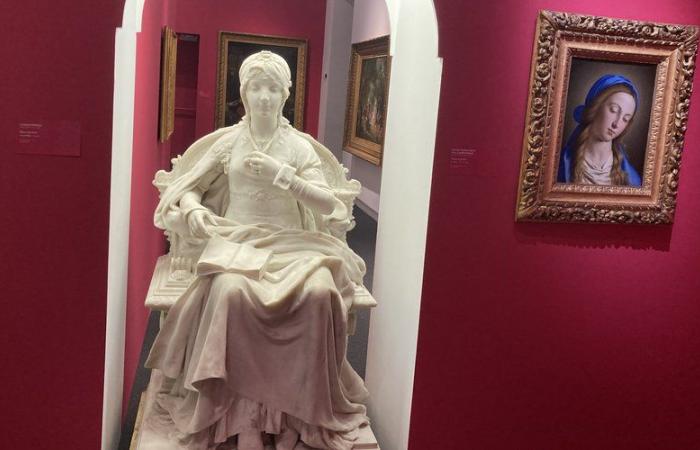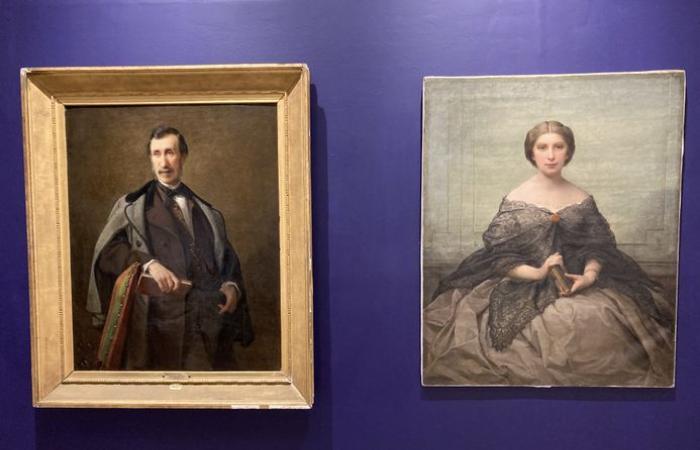A new display of the collections of the Museum of Fine Arts of Nîmes, to discover free of charge this first Sunday of the month.
By questioning the place of women in museums, especially in classic collections, it is a way of completely revisiting the history of art that Barbara Gouget, the new curator of the Museum of Fine Arts of Nîmes, offers with an exhibition “Feminine”, stimulating for the eyes and the mind. Women artists represent 5% of the collections, or around 200 works. This may not seem like much, but it’s not bad compared to many other comparable institutions. The exhibition does not just take women out of the reserves, it begins by questioning the way in which they are represented over the centuries, again with works little, rarely or never seen.
From the entrance, the famous 17th century virgin of Sassoferrato is placed opposite a Mystical Rose by Léopold Morice, sublime marble from a Nîmes forgotten by his compatriots but who still signed the allegory of the Republic, on the square of the same name in Paris. Soft figure, lively movement of the hand touching the collar, ample draping… The sculpture dazzles with this representation which looks more like a bourgeois woman of the time than a Virgin.
This first section entitled “Saint, executioner or victim?” presents several mythological or biblical figures. Cleopatra, Magdalene, the adulterous woman, Pandora, Lucretia, Salome… Women are often at the heart of theatrical representations, evoking love, sin, chastity.
The meaning is sometimes unclear and has evolved over time… Seduction by Pierre Paul Prud’hon? This is clearly sexual assault! A gallant scene after Godfried Schalcken in the 17th century is astonishing with its sensory overflow and the coins that the young woman keeps in the folds of her dress. In fact, it’s a brothel scene.
Nudes and mythology
With representations of mythology, here is a good excuse to represent nudes, especially when it concerns the beautiful Venus emerging from the waves. Very delicate, the representations of Leda and the swan still amaze with their gentleness while Zeus abuses the young woman. With Andromaque swooning with pleasure on her rock, we come close to the aesthetic of 80s advertisements! In the 19th century, the prudish century par excellence, the nude was everywhere, among orientalists like Emile Bernard, among Jean-François de Troy with his topless harvester who inspired Courbet, or in this scene from Joseph Belon’s salon, where good bourgeois , Legion of Honor in their buttonholes, slumming while admiring statues. It’s impossible to miss Foujita’s nude, one of the museum’s major pieces.
Mother, wife or muse, women also serve as models for artists. For years, Dominique Gutherz portrayed his wife in intimate scenes, very far from the distance with which Armand Coussens represents his wife Jeanne, a forgotten figure, also an artist and former director of the Museum of Fine Arts.
Forgotten women artists
Breastfeeding appears very different. In the very uncomfortable Roman charity by Simon de Mailhy, where a daughter feeds her father condemned to starve, in a rare nativity by Bartolomeo Guidobono or in the tender portrait of a mother with her child on her knees by Adélaïde Salles-Wagner.
The latter is one of the artists present in the museum’s collections. Wife of Jules Salles-Wagner (who added his wife’s name to his own!), she left behind a classic work, with a subtle treatment of textiles. She is at the heart of the last section of the exhibition dedicated to women in the collections. First surprise, the attribution of Liberality by Elisabetta Sirani, a rare female painter of the 17th century, one of the museum’s masterpieces, has varied. It may be from one of his students, Ginevra Cantofoli. “Research is evolving in art history, even more so for women, because they have been less studied”explains Barbara Gouget. It remains sublime, with its baroque chiaroscuro.
This room is also an opportunity to rediscover the orientalist paintings of Jeanne Thil, the watercolors of Jeanne Coussens, a large plaster cast by Jeanne Itasse-Broquet, the marble double of which sits at the Opéra Garnier, or a delicious cup of tea by the English painter Helena Darmesteter, between tradition and modernity.
Opposite, the museum houses some paintings by Etel Adnan, on loan for Carré d’art, proving that fortunately, this story remains open and continues!







